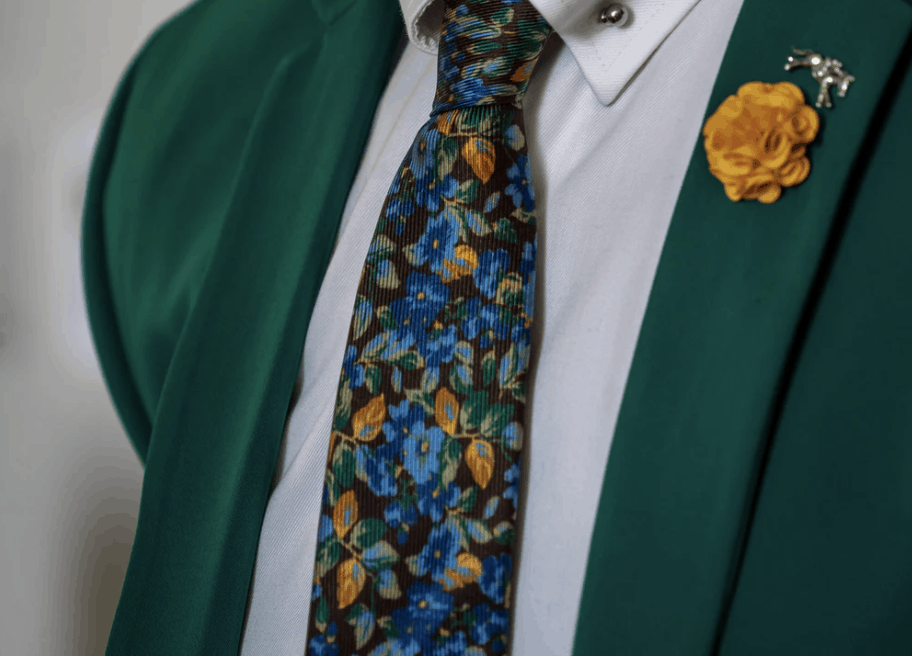Neckties, or some kind of cloth around men’s necks, originated two millennia ago, as early as the Roman Empire, when wearers used it as a sort of handkerchief and a covering for the mouth against foul odors. Later in the 1700s, during the 30-year war in France, men began wearing neckties to fasten their jackets closer to their necks as protection against the weather. Neckties gained popularity for their style in England in the 1800s, but it wasn’t until the 1920s that ties resembled their modern appearance. Many assume the tie has always come in a “one size fits all,” and long enough (or short) for wearers to adjust around the neck. But this is not the case.
So, do men’s ties com in different sizes? The answer is yes, both for width and length. Men who are taller need longer neckties, and ties come wider or narrower based on changes in fashion trends. Differences in tie width were in vogue, from the 6” wide “Kipper Ties” of the 1960s to the “Skinny” Tie” that became the standard tie in the 1980s.
Throughout the first decade of the 21st century, the standard width for a tie was three and a half inches. Since 2013, ties now range in width from the skinny tie to the kipper tie, and everywhere in between. The width of neck ties is no longer a standard size, and ties have become another way of expressing individuality.
Tie length, however, remained standard through the phases of changing tie widths. Lengths are either by “regular” tie length (between 57” and 58”), or ties for tall men, in extra-long sizes between 62 and 64 inches.
Table of Contents
Are All Ties Made the Same?
Ties are made with different fabrics and are also put together differently. Less expensive ties are made out of less expensive fabrics such as polyester and microfiber. More expensive, quality ties are made from silk, wool or cashmere. Some of the advantages of silk ties are how they naturally “drape” down the body, appearing less stiff and contouring to the body. Silk ties also have a natural sheen and appear more natural-looking under artificial light indoors.

Not all neckties are the same. Aside from differences in fabric, they differ in the way they’re constructed. A tie put together by hand or partially by machine will last longer and hang more naturally from the neck. Poorly made ties will not retain their fashionable shape, even if made from silk. Both the fabric and how a tie is constructed is important. It’s best to spend a little more on a well-made tie with quality fabric for a couple of reasons: A well made tie will last years longer than a poorly made one, and ties are replaced with much less frequency than pants or shirts. You will always know you look your best with a quality tie, no matter for which occasion you wear it.
The Parts of a Tie
- The seam is found on the back of a neck tie and should not be visible after the tie knot is made. A seam is created when two pieces of fabric are sewn together. When purchasing a tie, check to see if the patterns that come together at the seam match and are in line with each other. Patterns that are aligned is an indication that the tie is higher quality.
- Tie shell. The outermost material of a neck tie is the shell, also referred to as the envelope. The shell also maintains the shape of the tie. The shell can be made out of polyester, silk, cashmere, cotton, satin, linen or wool.
Neck tie shells made from quality materials will tie easier around the neck, and will drape better down the front. Fabrics that go into the highest quality neck ties are wool, silk and cashmere.
- Bar Tack. The bar tack is stitching that crosses the seam on the back of the tie and holds the two parts of the tie together. It is found underneath one of the pieces of fabric so will be invisible on the back of the tie.
- Keeper Loop. This loop is found on the wider end, or “blade” of neck ties. Perhaps you can infer from the name, the keeper loop, stitched across the seams horizontally, and is the place where you run the narrower part of the tie through so it remains in place; only the blade of the tie is seen. After knotting the tie, run the tail of the neck tie through the keeper loop before making the final adjustment to the knot.
- Rolled Edge. Located on the sides of the tie, where the fabric runs from the back to the front. The edge should appear “rolled”, as opposed to creased. Better tie shell materials like silk and wool will form a natural rolled edge.
- Care and Origin Tag. This tag is found at the back of the tie, sewn into one of the sides of the tail end. The tag shows the tie’s origin country of manufacture and will also have special care instructions.
- Slip Stitch. A single stitch of thread runs along the entire length of the inside of the tie, known as the slip stitch, and it works to keep the seam sewn in place. Sown loosely inside the tie and under the seam, it also works to prevent the seam from coming apart from repeated knotting.
How Are The Best Quality Ties Made?
There are easy ways to determine if a tie is made well, by the look and feel of it.
Look at the fabric of the tie.
Keep in mind, though, that even if the tie is made from a high quality fabric like silk, it doesn’t necessarily mean the tie is higher quality. There are different kinds of silk fabric in varying degrees of quality. Always look for a silk tie that is heavy in weight and tight in construction. Too often, someone buys a silk tie and it doesn’t hold together when worn. Thread count is very important.
Evaluate the tie’s construction.
Take a tie from the rack or the shelf in the store and hold it up by its narrow tail. See if the tie twists around or whether it hangs straight. Select the tie that stays immobile because a tie that twists won’t hang correctly after it’s tied. It will tend to twist while you’re wearing it, forcing you to constantly twist it back.
Next, lay the tie flat on a table to view the seam, and make sure each side of the seam is symmetrical; the tie should have the same amount of fabric on each side of the seam. If it doesn’t, then the tie won’t drape the front of your body properly, and will hang to the left or the right of center.
Choose woven rather than printed ties.
Woven ties cost a little more, because they take longer to make. Printed ties have colored patterns such as polka dots, sport-themed or paisley, printed directly onto the silk. Woven ties are different: the color patterns are sewn into the tie with a loom, and appear more elegant and the patterns appear more natural. In addition, the weave adds weight to the tie (so it tends to stay in place), as well as texture. Bigger and tighter knots can be made with a woven tie.
Should I Order a Tie Online?
A lot of the quality of a necktie needs to be seen and felt in your fingers, and it’s great to shop at a men’s tie shop because it’s likely the salespeople understand more about ties than going to the mall and picking one out from a department store tie rack. Of course, lots of department stores have good ties, but since neck ties are special purchases, a men’s store will often have the most knowledgeable staff.
If you decide to purchase a tie online, make sure the description has a lot of detail. The description should indicate that the tie is made from high density silk, is heavy, and that it is handmade. Also make sure the ties contains no polyester or microfibers.
Cotton neck ties can be a good choice, but remember that it will have a flat, matte appearance, unlike silk which will reflect light and will shimmer.
Even if an online retailer claims the tie is 100% heavy silk, the tie will look better in the photo than it will when you get it. Also, the tie can come wrapped in plastic and folded inside bubble wrap, so it might be wrinkled when you take it out. If your tie is wrinkled use a hand steamer rather than an iron. Hand steamers are inexpensive and they don’t come into contact with the tie.

